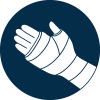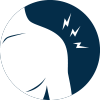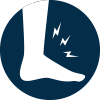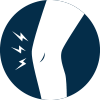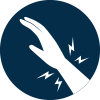CSMOS surgeons routinely treat a wide range of bone fractures, both non-surgically and surgically. Growth plate fractures are a common condition we treat in children due to injuries occurring at the end of a long bone, which is last to ossify. Complicated fractures that require surgery can involve:
External Fixation: Metal pins or screws are placed above and below the fracture and then connected to a bar located outside the skin.
Internal Fixation: Bones are repositioned with metal pins, screws, or plates that are placed internally.
Shoulder Separation: The acromioclavicular (AC) joint becomes separated from the collarbone (clavicle) due to a downward fall or force.
Frozen Shoulder: The connective tissue of the shoulder can become inflamed and cause chronic pain and a decreased range of motion.
Rotator Cuff Disorder/Shoulder Impingement: Tendons in the rotator cuff are squeezed between the acromion and the humerus (often noticeable when the arm is raised), causing inflammation and discomfort.
Torn Rotator Cuff: Tendons or muscles of the rotator cuff can be torn partially or completely, often by a sudden blow to the shoulder, such as a sports injury, or from wear and tear gradually.
Shoulder Dislocation: The head, or ball, of the upper arm bone, comes out of the socket that it normally rests in, often due to a traumatic event.
Labral Tears: Superior labrum anterior-posterior (SLAP) tears and bankart tears can occur when shoulder cartilage becomes torn. Athletes who repeatedly perform an overhead motion (such as pitching, swimming, and serving) are especially susceptible to labral tears.
Shoulder Tendonitis: The tendons surrounding the shoulder joint become swollen or inflamed.
Shoulder Bursitis: Inflammation can occur involving the sacs of fluid that reduce shoulder joint friction (bursae).
Ankle Instability & Arthritis: These conditions may be treated with arthroscopy (using a small camera to view the inside of the ankle to assess the bones and cartilage. Total ankle replacement may also be needed to treat damaged or degenerated bone and cartilage.
Achilles Tendon Rupture: This injury affects the back of the lower leg where the muscle that connects the back of your calf to your help bone tears partially or completely. These tears cause immediate sharp pain and affect the ability to walk properly.
Bunions & Hammertoe: This involves straightening the bones that cause these painful and uncomfortable conditions.
Flat Foot Deformity & High Arches: A combination of procedures may be needed to address the ligaments, tendons and bone alignment to reconstruct a flexible, flat foot.
Foot & Ankle Fractures: When a fracture is unstable, displaced or affects a joint, surgery may be needed to restore bone position, stabilize the joint and restore function. It also reduces the likelihood of lingering symptoms like stiffness or arthritis following an injury.
Great Toe Joint Arthritis: This painful condition occurs when the cartilage of the big toe joint becomes eroded, leading to limited motion, rigidity, inflammation and pain.
Metatarsalgia: Commonly described as pain in the ball of the foot, this condition involves the bones connecting the ankle to the toes.
Morton’s Neuroma: The condition involves a thickening of tissue around the nerves leading to your toes that causes sharp, burring pain in the ball of the foot. Decompression surgery or removal of the nerve may be needed to provide relief when conservative treatments fail.
Plantar Fasciitis: This common cause of heel pain involves inflammation of the tissue that runs across the bottom of the foot and connects the toes to the heel bone.
Medial Epicondyle Apophysitis (Pitcher’s Elbow): The growth plate inside the elbow can become inflamed, especially in young athletes, due to overuse.
Ulnar Collateral Ligament (UCL) Injury (AKA Tommy John Injury): Nicknamed after a pitcher with the condition, this injury involves the deterioration of the inner elbow ligament that connects the ulna to the humerus, causing the elbow to become unstable.
Lateral Epicondylitis (Tennis Elbow): Comprising almost half of all elbow injuries/disorders, this condition occurs due to overuse of the tendons and muscles around the outer elbow, causing pain and weakness when bending the wrist backward or spreading the fingers.
Medial Epicondylitis (Golfer’s Elbow): This overuse injury involves the muscles and tendons of the inner elbow and is typically caused by activities in which stress is placed on the elbow while the wrist and fingers are clenched (such as grasping a tool or golf club).
Ulnar Nerve Entrapment/Ulnar Neuropathy (Also Called Cubital Tunnel Syndrome): The nerve running down the inner arm can be compressed, causing tingling, numbness, or weakness in the ring and pinky fingers.
Adolescent Anterior Knee Pain: Often occurring in young athletes, chronic pain can occur in the center of the knee due to injury or overuse.
Cartilage Damage: Connective tissue that cushions the knee can be damaged, causing swelling, stiffness, or pain.
Meniscus Tear: Cartilage in the knee can become ruptured due to traumatic injury (usually in younger patients) or degeneration (due to prolonged wear and tear).
ACL (Anterior Cruciate Ligament) Injury: Often due to a sports injury, the ACL can be torn or sprained during a sudden stop or twist of the knee, such as turning or landing abruptly.
Knee Replacement: Knee arthroscopy can be utilized to replace a knee joint that has been damaged due to osteoarthritis (wear and tear), rheumatoid (inflammatory) arthritis, or post-traumatic arthritis from an injury. Total and partial knee replacement surgeries are regularly performed at CSMOS.
Carpal Tunnel Syndrome: Swelling of the medial nerves that run from the forearm to the hand can result in numbness, tingling, and/or weakness in the affected hand.
Compartment Syndrome: Typically occurring after an injury, swelling or bleeding within an enclosed muscle space can cause painful pressure build-up, as well as decreased blood flow.
Cubital Tunnel Syndrome: Inflammation, swelling and irritation of the ulnar nerve, which passes through the cubital tunnel – a tunnel of muscle, ligament and bone – located on the inside of the elbow.
Boutonniére Deformity: Inflammation or injury of the tendon in the finger can cause deformity characterized by an inability to straighten the finger.
Dupuytren’s Contracture: Tissue in the palm can form knots or a thick cord under the skin, causing the fingers to contract.
Ganglion Cyst: This benign, fluid-filled lump that forms in the wrist or hand can vary in size and cause pain with wrist activity.
Mallet Finger: The tendon in the end finger joint or thumb joint can be injured after being hit by an object, such as a ball, and result in the inability to straighten the digit.
If you are experiencing pain or discomfort of the bones, joints, muscles, or other soft tissue due to injury or wear and tear, the board-certified orthopaedists at CSMOS are here to help. Our doctors offer accurate diagnoses and innovative, cutting-edge treatments to restore every patient to an active, healthy lifestyle.

